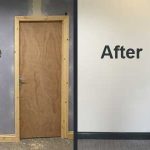After plastering, its quite common for people to try speeding up the drying process. A first instinct might be heating the property to speed things along. This can be particularly true if the weather is cold.
However, it’s important that plaster dries correctly. This means that it needs time to dry as naturally as possible. So, how soon after plastering can you turn your heating on?
It is recommended that plaster is left to dry naturally. Speeding up the process with additional heat can cause cracking.
While there is no hard or fast rule, it is possible to use the heating around 48 hours after. However, you should keep the heating at a low temperature and ensure that the room is well-ventilated. The main aim is to give the plaster time to dry correctly, as this will ensure a perfect finish.
Does plaster dry faster with heat?

As with any drying process, once you add additional heat, you can speed up the drying time. When plaster is mixed, a chemical reaction takes place, and this makes the plaster pliable enough to apply to walls. As it begins to dry, the chemical process continues, and the plaster hardens.
For the ideal finish, you should allow plaster to dry with good ventilation. It might be tempting to use a heater and turn the heat up high, but this could lead to issues with the finish. It can obviously dry quicker with heat, but you should avoid using high temperatures as part of the process.
What is the ideal temperature for drying plaster?
Where possible, you should avoid putting your heating up too high. In most households, the average temperature ranges between 18 and 25 degrees. The lower end of this would be more suitable. At the higher end, you run the risk of the plaster cracking as it dries.
The main thing to remember is drying plaster requires a constant temperature and good ventilation. On average, it takes around two to three days for plaster to dry, following this you are usually safe to start decorating.
In the drying process, ventilation is just as important as temperature. A low, warm, constant temperature with good air circulation, will provide the best possible conditions for plaster drying. This will allow air to move freely around the room, while also allowing condensation to escape
So, it is possible to speed up the drying process by using a small amount of extra heat. However, forcing the process with high temperatures could lead to problems.
Should the temperature be cold (in winter for example), then this will draw out the drying time. It might feel right to use additional heat. However, you should leave it 48 hours, and then make sure you don’t overdo it. By blasting the room with heat, it will help the plaster to dry out faster. However, it could cause the plaster to crack, which means that additional work will be needed to fix any problems.
Why drying naturally is better
As we mentioned previously, plaster is made using ingredients, that create a chemical process when mixed with water. If you add to much heat, you speed up this process, causing the water to evaporate too quickly, which can result in cracking. Therefore, the aim should be to allow nature to take care of the process.
In the best case scenario, you should avoid using heat or dehumidifiers to speed up the drying process. During the winter months, the natural process can take up to seven days, so if you’re not in a rush, just keep the room well ventilated. However, in summer the drying process can be much quicker. It can be as little as one or two days, so, allowing natural drying is always the best option.
Whatever the time of year, it is important to ensure you have doors or windows open. This will help with ventilation and remove excess moisture from the room.
Conclusion
Your aim should be to allow plaster to dry as naturally as possible. It is a chemical process that causes plaster to dry and set, which is why you should try to avoid influencing the drying time where possible.
While it is possible to use your heating at lower temperature, you should avoid using it for 48 hours after plastering. Even then, you should not overdo it. If you take care of the drying process, you can be sure that you will get the best finish possible.




